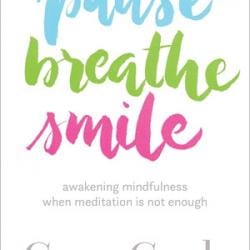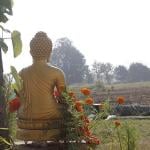A guest post by Tom Clements
Editor’s note: As this year’s election season winds down, here’s a pause from our political discussions with little help from across the pond.
Meditation, like any skill, requires a lot of practice and perseverance. It’s not what many of these self-help guides and relaxation tapes will have you believe. You don’t switch off your brain by imagining yourself on a Bahamian island with white sandy beaches and warm turquoise waves lapping at your feat. It’s firstly a process of stepping away mentally from the ceaseless bombardment of your thoughts, observing them from a distance and recognising their transient and elusive nature. Once you can sustain this feeling, you can fully concentrate on one thing. My first object of concentration, which all Buddhist schools seem to emphasise for beginners, is the breath. Focusing on just breathing in and out proved a huge difficulty for me and at one stage I thought I would never be able to overcome it. As I started to breathe in and out, I would notice sounds outside like a car engine revving, a strimmer, birds’ twitter or my poor neglected stomach growling.
Eventually after many frustrated attempts, I got better and better at just letting go and simply going with the in and out flow of air. The trick is to let yourself become distracted by things outside until the distractions die down and you can begin the real work of concentration. Keeping the breath not too deep or too shallow but natural is also key. Eventually the maelstrom of mental chatter fades into the background and you feel yourself entering an empty space unencumbered by conditioned thought. You would think such an exercise would induce a gently lulling or somnolent effect, but in fact it actually increases your alertness. Being less distracted by your inner-world, your perception of the outside phenomena becomes crystal clear.
Being an overly ambitious type, I at first attempted to meditate for 30 minutes at a time which was akin to mental torture for someone like me with a restless mind. Not only that, sitting in the lotus proved not only painful but also dangerous because I risked cutting off the circulation to my lower legs and feet due to how contorted they were. Subsequently I adopted the semi lotus which was also uncomfortable though less likely to induce DVT. Eventually I even gave up sitting on the floor altogether and just sat in an unfashionably orthodox position on an upright chair. Gradually I shortened my 30-minute sessions to just 12 minutes which I found to be more than enough for a novice contemplative. Consistency, as with any form of practice like playing the piano or learning a new language, is the most important thing. Eventually 12 minutes became 20 which is now my minimum requirement for each day. Unlike the Zen monks who rise at the ungodly hour of 3am to recite sutras and meditate sometimes for 3 hours at a time barefoot in a cold room with tatami floors, I prefer to do mine after a period of activity, usually after I get home from work and have eaten dinner, and in the comfort of my warm, carpeted bedroom. That way I can give it my undivided attention. If I were to do it in the mornings, there’s always the chance I would nod off which wouldn’t be a good thing, especially if I were to miss work because of it.
Once you begin to grasp the technique of non-attachment to thoughts by focussing on the breath, you can gradually begin to meditate on the sorts of positive emotions and feelings you wish to cultivate within you and sustain in your daily life. The Tibetan schools focus heavily on compassion, the motivating factor behind the Buddha’s enlightenment, and encourage practitioners to meditate on loving-kindness almost exclusively when going into retreat. The best way to do this is to first imagine a loved one and focus on them and allow feelings of unconditional love to fill your heart to the brim for 20 minutes or so. In my case, I meditate on each family member starting with my mum. While I would dispute dubious New-Age claims that love can heal minds and bodies, it certainly increases a feeling of wellbeing, but in order to truly feel it and allow it to be the motivating force behind all your actions and interactions in daily life, it is vital you extend that love to the entire human family, even to those you dislike or regard as enemies. Recognising that we are all essentially the same despite being conditioned by different circumstances, cultures and religions, and that we are all appallingly fragile, vulnerable creatures subject to the indisputable fact of impermanence increases empathy and feelings of social connectedness.
It’s through such practice, you begin to realise you are not alone in your suffering. You begin to put yourself in others’ shoes, imagine what they might be going through and what challenges and perhaps even heartache they face on a day-to-day basis. Such an attitude doesn’t eradicate the pain you experience, but it does greatly reduce your negative response to such suffering and increases your resolve to relieve the suffering of others by being more altruistic, kinder and gentler.
As I maintained loving-kindness meditation for several weeks, my own suffering began to seem trivial in comparison to that of the world around me. I became more acutely aware of suffering in all forms experienced by others. You begin to feel their struggle, their pain, their exhaustion and this in turn reduces your response to your own suffering. Such an attitude calms the inner tumult and transforms you over time into a person, much like His Holiness the Dalai Lama, into someone who at the very core, has others’ interests at heart and goes out of their way to achieve peace and harmony between people to reduce their suffering. Such a noble attitude can only be achieved by first filling your heart with kindness and letting it infuse into the very fabric of your very being.
 Tom Clements is a 28-year-old teacher from Bishop’s Stortford, UK. He was diagnosed with Asperger Syndrome 5 years ago and is now an advocate of the neurodiversity movement. He is looking to find a publisher for his memoir ‘The Autistic Buddha: An Unconventional Path to Enlightenment’.
Tom Clements is a 28-year-old teacher from Bishop’s Stortford, UK. He was diagnosed with Asperger Syndrome 5 years ago and is now an advocate of the neurodiversity movement. He is looking to find a publisher for his memoir ‘The Autistic Buddha: An Unconventional Path to Enlightenment’.












